Driving E-commerce Success in Your Secondhand Retail Team
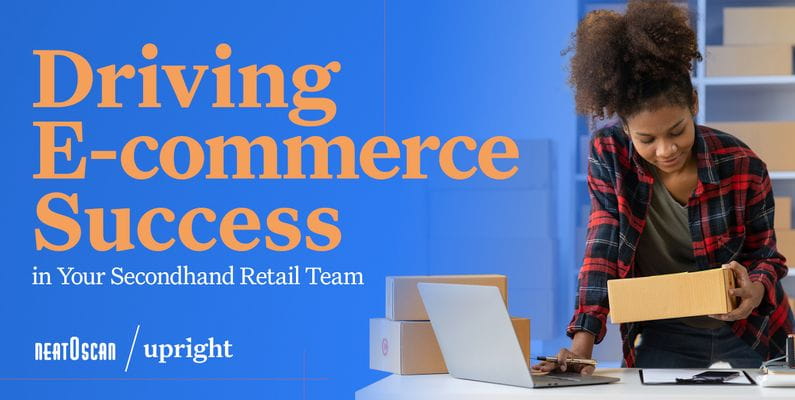
In today's retail landscape, e-commerce isn't just an option; it's a necessity. For secondhand organizations looking to leverage their potential on online marketplaces, the question is not "if," but "how."
How can you seamlessly integrate your physical retail stores to be in sync with your e-commerce operation? How can you motivate your in-store teams to recognize the growth potential that online sales represent? Most importantly, how can you create a cohesive team that’s skilled in identifying valuable secondhand items suited for the broader, more lucrative online market?
E-commerce can reach more people and often brings in more money and profit. If it's hard to get your stores on board with this big change, you're not alone. Many secondhand businesses struggle with staff changes often. This means they need ongoing e-commerce training and face delays in finding and listing products online. These challenges can make it harder to work together smoothly across both physical and online stores.
This article aims to give you practical strategies and tips to help your team fully commit to your e-commerce goals. We will talk about ways to communicate the benefits of online sales and share easy methods to spot items that will sell well online.
Whether you already have an established e-commerce department or are in the initial stages of building one, this article promises to be a catalyst for sustainable, revenue-driving change.
The Potential In E-commerce
The potential for secondhand organizations to expand into e-commerce is not just significant; it's transformative.
Online marketplaces like ebay, Shopify, ShopGoodwill, and more offer a global audience that far surpasses the geographical limitations of a brick-and-mortar store. According to a report by ThredUP, the secondhand market is set to hit $70 billion by 2027. A large portion of that growth is attributed to online sales. By extending into e-commerce, secondhand businesses not only cast a wider global net to prospective buyers but also open the door to lucrative opportunities that simply don't exist in a physical retail setting for certain items.
E-commerce is key to sustainability, a big concern for today's shoppers. Selling used items online makes them last longer and supports a circular economy. This attracts customers who care about eco-friendly shopping and are willing to pay more for these options online.
The operational advantages of e-commerce can't be ignored either. Automation and data analytics tools allow for streamlined inventory management, dynamic pricing, and targeted marketing—features that can drastically improve margins. While the initial investment in technology and skills training may be a short-term hurdle, the long-term ROI is promising. A recent study by Shopify revealed that retailers who adopt an omni-channel strategy, incorporating both physical and online sales, see a 30% higher lifetime value from their customers compared to those who use a single channel.
Moving into e-commerce gives secondhand businesses big chances to increase revenue, be more sustainable, and work more efficiently. The market is ready and the tools are there. The main question is how your business can adapt and make the most of these opportunities.
Communication Is Key
Gaining employee and store buy-in for e-commerce initiatives is critical in supporting your operation’s growth. The overarching key to success here is effective education and communication. According to a study by McKinsey, companies that prioritize communication are 3.5 times more likely to outperform their peers. The importance of e-commerce in your organization’s growth strategy must be clearly articulated to all team members, and this can be efficiently done through various methods.
At Neatoscan & Upright, we find that communication highlighting valuable data and metrics can be powerful motivators for our secondhand clients. Simply communicating and educating teams on criteria like average prices per item, popular brands and categories, boost both the quantity and quality of products sent for online sale.
Here are two examples where our secondhand clients saw immediate team buy-in and a surge in quality product volume sent to e-commerce after implementing store communication campaigns:
In example 1, you’ll note the increase after May when communication pieces started going out to their team. This particular organization saw an increase in their e-commerce product flow by July.
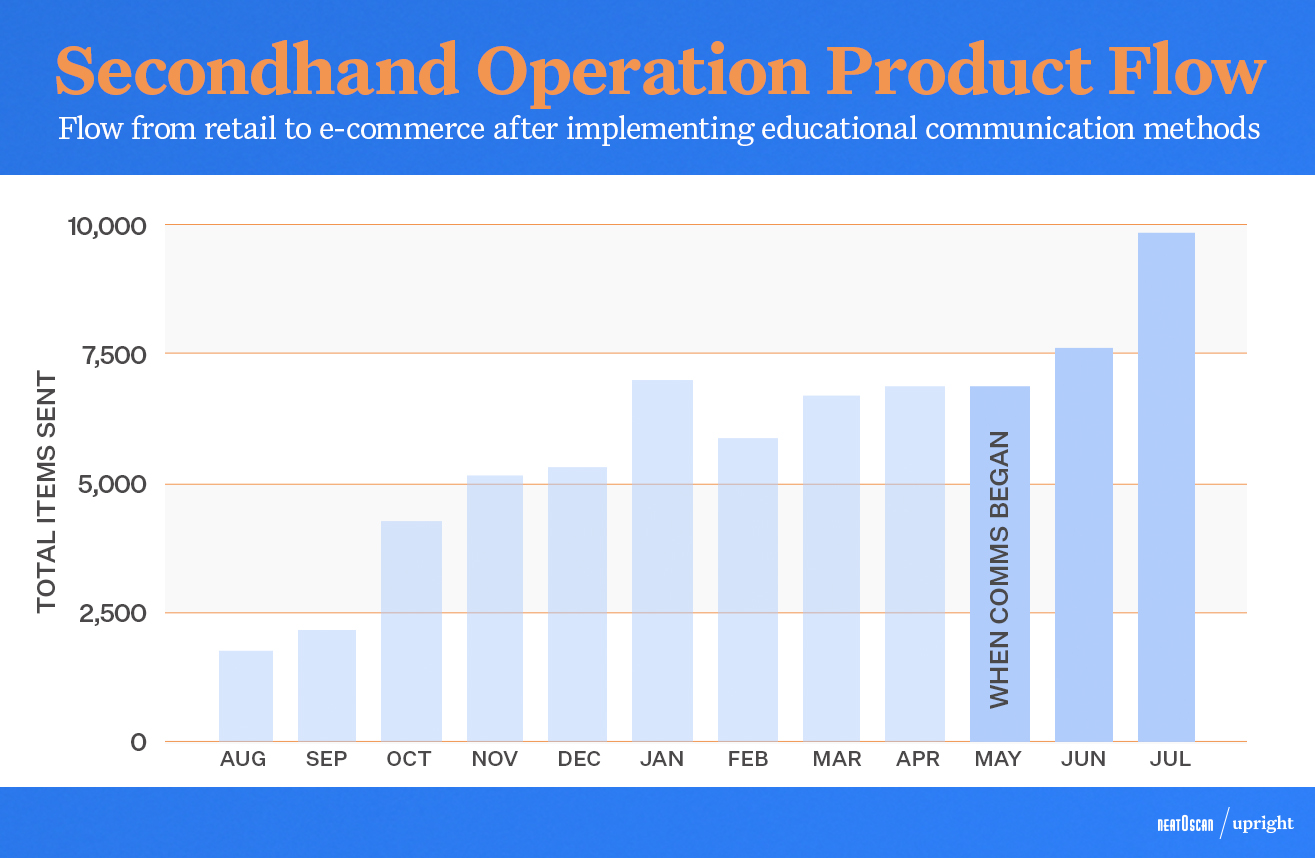
In example 2, communication pieces began distribution to their staff in October. Afterwards, their operation’s e-commerce product flow increased month-over-month.
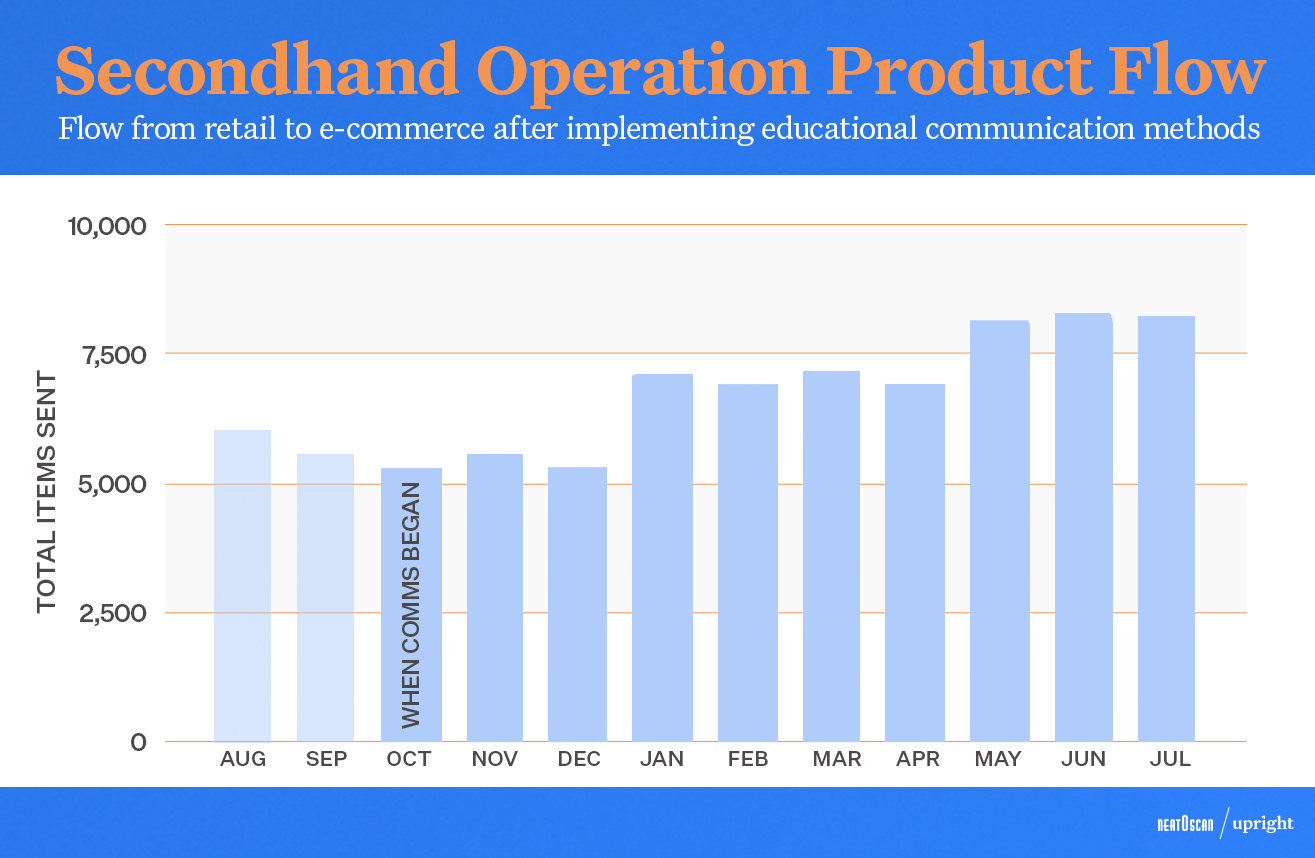
5 Methods You Can Use
With communication as the key to gaining team buy-in on e-commerce, what can you do?
Here are 5 powerful methods we’ve seen success with and suggest using. These will educate your team on the power of e-commerce working collaboratively with retail’s goals. In turn, you’ll have them regularly thinking about how they can contribute and increase the quantity and quality of products they send for online listing.
Email Communication:
A cadence of scheduled emails that highlight valuable metrics can be powerful motivators. Send out a monthly email that highlights important metrics. Include comparisons like the average price of items sold online compared to in-store. Spotlight the brands or items that make the organization the most money. All the while, highlighting how much your online sales have grown. Adding clarity to what’s going on in e-commerce can keep it top-of-mind and keep the team engaged.
Start with this example for your emails:
Good Morning Store Teams,
We wanted to let you know about our top categories right now and some information about them. We are seeing success in these top categories that we hope will assist in the products you are sending in
Top Categories:
Category 1: Women's Clothing
-The average price of $XXX
-Top item sent by Store 1 sold for $XXXSee item here [link to the item on marketplace]
Category 2: Collectibles
-The average price of $XXX
-Top item sent by Store 4 sold for $XXXSee item here [link to the item on marketplace]
Category 3: Toys
-The average price of $XXX
-Top item sent by Store 1 sold for $XXXSee item here [link to the item on marketplace]
Category 4: Musical Instruments
-The average price of $XXX
-Top item sent by Store 2 sold for $XXXSee item here [link to the item on marketplace]
Category 5: Furniture
-The average price of $XXX
-Top item sent by Store 4 sold for $XXXSee item here [link to the item on marketplace]
Reporting:
Another technique we’ve helped employ with success are visual slideshows or guides of the products that are hot sellers online.
Many retail stores have high turnover or visual learners. For these organizations, we suggest using displayed imagery of items in these categories:
- High selling quantities
- High average PPI
- Top selling item price

Both Neatoscan & Upright Labs have an API endpoint that you can use to quickly create supplier reports. We recommend your organization focuses on on these value drivers:
- Categories
- Item Revenue
- Category Average PPI
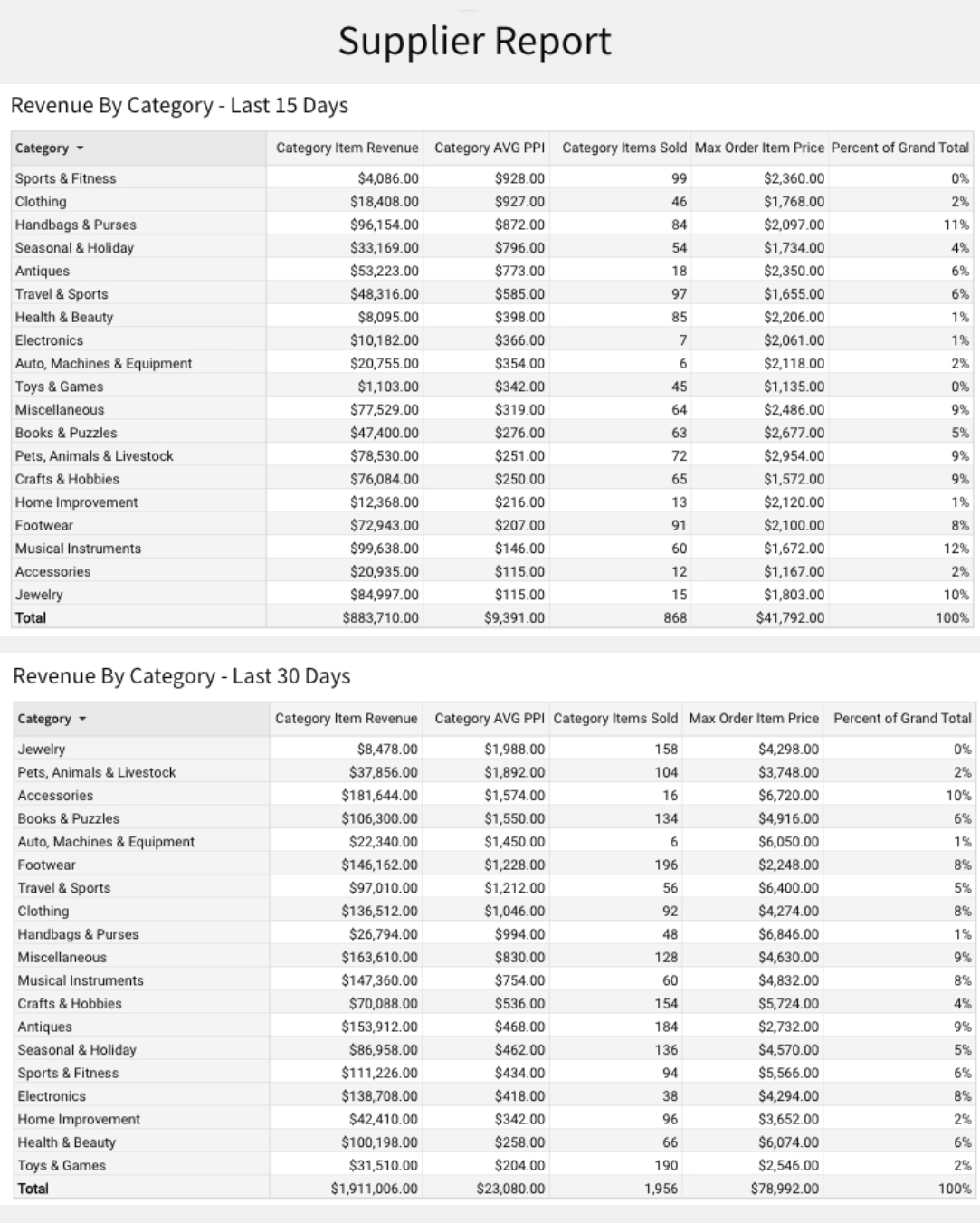
Store Crediting:
Another way to motivate your teams is through store crediting. Incentivize your retail teams to send their higher value items to e-commerce.
This means openly sharing key statistics and information about the profits being generated through online sales. When teams can see the impact they are making, they are more likely to contribute to help support the effort. You should see an increase in quality products designated to be sold on e-commerce, because they can see tangible results from their efforts.
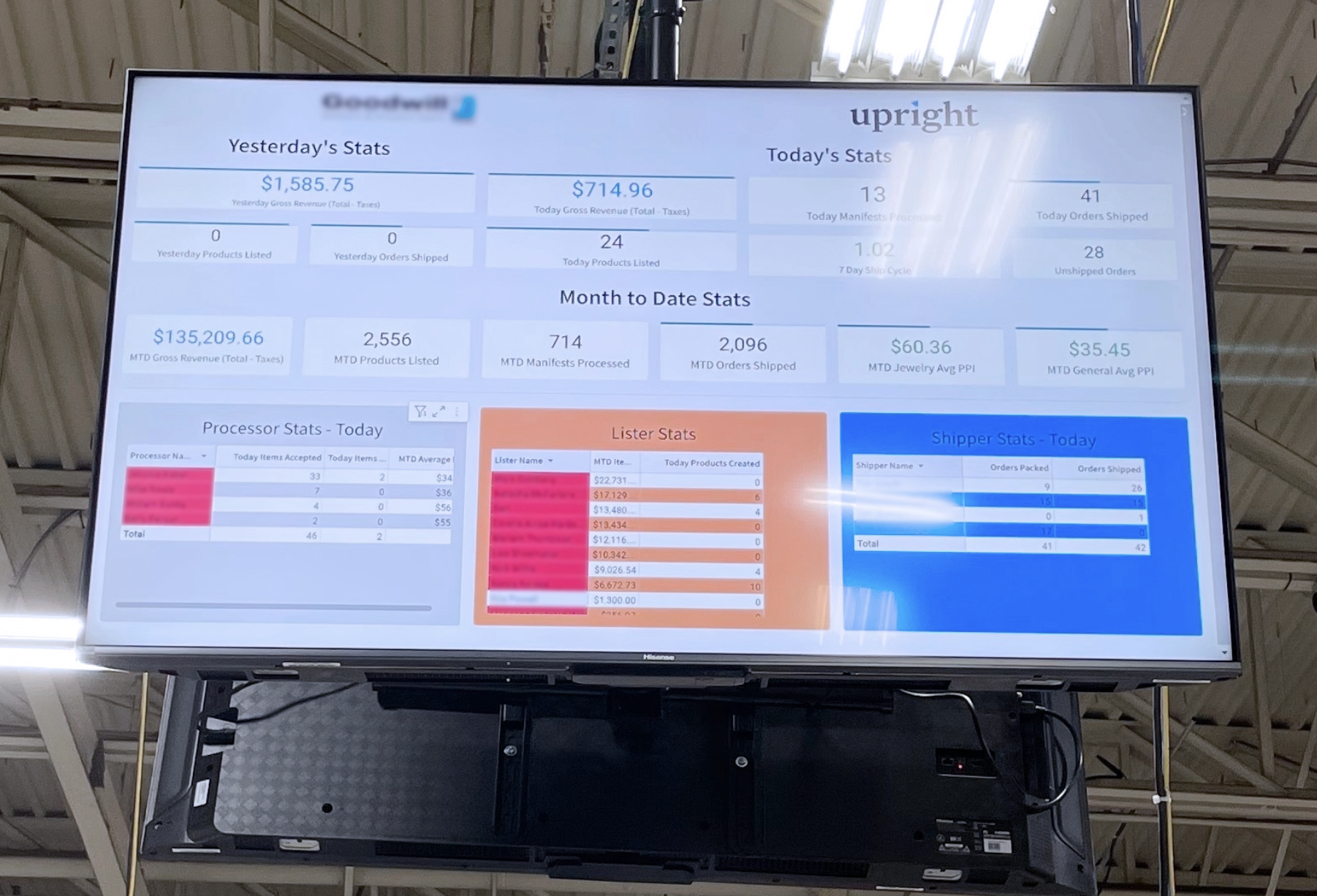
Friendly Competition:
Incorporating a little friendly competition never hurts either.
E-commerce managers can send out periodic updates spotlighting which stores are sending the most products for online sale. These updates can be displayed on monitors in break rooms, warehouses, and other high-traffic areas. They can also be utilized as printouts tacked to bulletin boards. Employees will likely become more engaged if there is a competition aspect involved. Fostering this culture of friendly and healthy competition can become a booster for products sent to be sold on e-commerce.
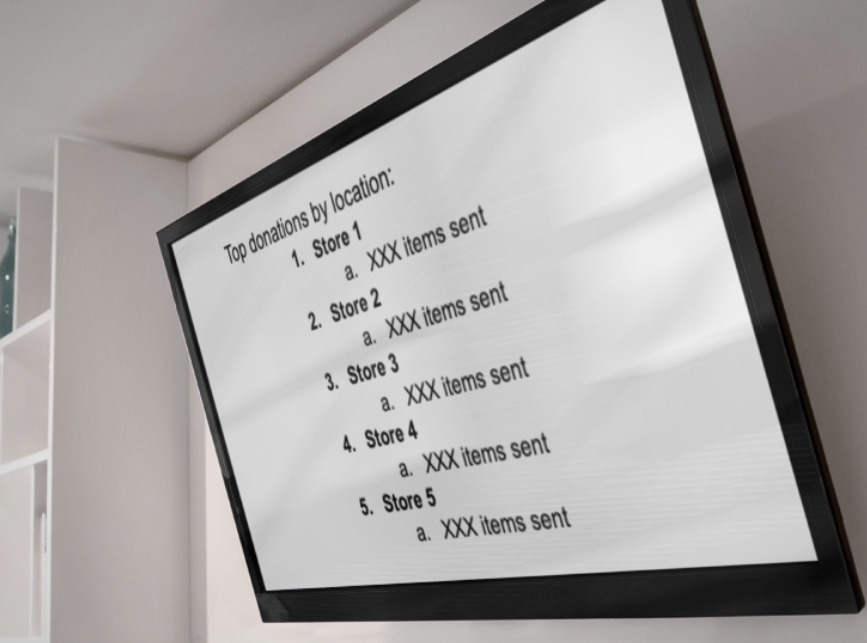
Leverage Data:
Leverage the reporting tools offered by Neatoscan and Upright Labs (or your preferred solution provider) to help add clarity to the impact e-commerce is making.
These built-in analytics tools provide real-time data and insights on how much product is being listed online and how much is being sold. When employees see how their work directly helps the e-commerce part of the business, it makes them feel proud and more committed.
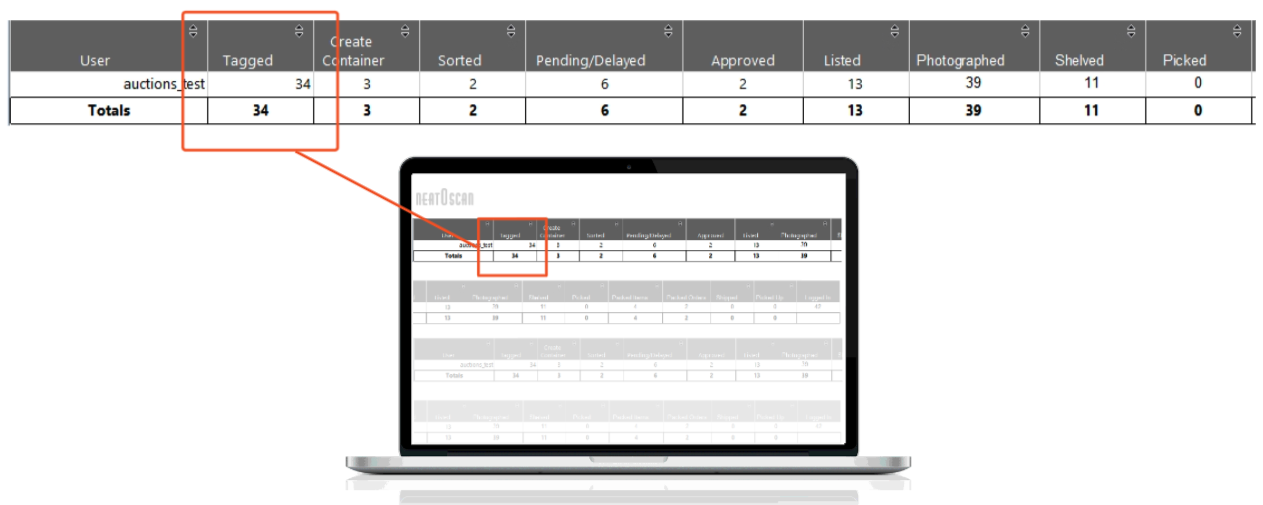
Teach and talk to your team about your e-commerce plans. Share data, promote friendly competition, and show results. This will help build a team that is excited and driven to boost online sales.
Unlocking the full potential of e-commerce in the secondhand industry isn't a solo act—it's a team effort that requires buy-in from every level of your organization. From store teams to e-commerce units, all the way up to leadership, everyone must be aligned and committed to the collective vision.
This isn't only about using the right tools or strategies; it's also about building a culture where e-commerce is seen as integral to growth. So, as you consider implementing the techniques, insights, and tools discussed, including offerings from Neatoscan and Upright Labs, remember that your success hinges on comprehensive organizational buy-in.
When everyone's on board—the sky's the limit for your e-commerce success.
